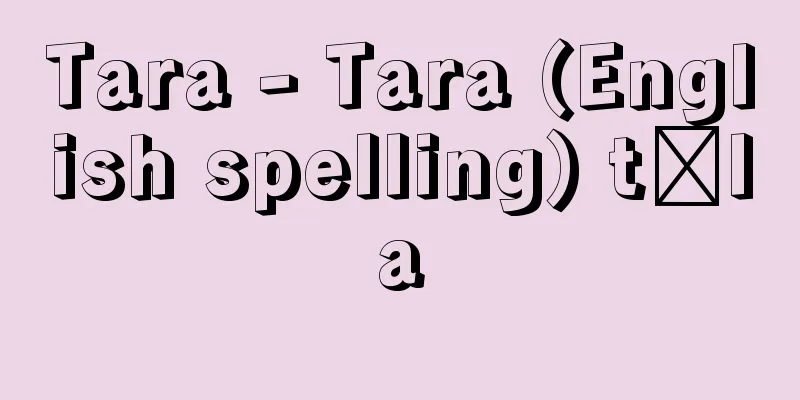Tara - Tara (English spelling) tāla

|
A theory of Indian music meter. Along with the modal theory of raga, it is one of the two major pillars of Indian art music. Tala means "to clap hands", and in North India it is called taal. In South India, the number of beats is represented by three symbols: (1 beat), ○ (2 beats), and | (3, 4, 5, 7, or 9 beats), and these symbols are combined to create seven main talas. There are five types of beats in |, so there are a total of 35 talas. The most common Adi tala has a cycle of |○○=4+2+2, a total of eight beats. In each tala, the strongest beat is placed on the first beat (sam) of the cycle, and the strong beats are placed on the first beats of each section (beats 5 and 7 in the previous example). The speed is kept constant throughout the piece, but there is a technique called kala that condenses one cycle of rhythm into a half cycle or a quarter cycle. In North India, it is more practical and less systematized than in the South. The commonly used Teen Taal has a cycle of 4+4+4+4, a total of 16 beats. The first beat of the cycle is the strongest beat, the fifth and thirteenth beats are strong beats, and the ninth beat is an unaccented blank beat. The strong beats and blank beats are determined by the Taal. The speed of the song starts slowly and gradually speeds up, eventually reaching about four to eight times the original speed. In both North and South India, the tala is struck in a unique way, and the song begins and ends with sam. It is said that drums such as the mridanga and tabla best express the tala. [Noriko Shibata] Source: Shogakukan Encyclopedia Nipponica About Encyclopedia Nipponica Information | Legend |
|
インド音楽の拍節法に関する理論。旋法理論ラーガとともにインド芸術音楽の二大柱となっている。ターラとは「手を打つ」の意で、北インドではタールという。 南インドでは、拍数を(1拍)、○(2拍)、|(3、4、5、7、9拍のいずれか)の3記号で表し、これらの記号を組み合わせて7種の主要ターラをつくる。|に5種の拍数が入るので、計35のターラに整理される。もっとも一般的なアーディ・ターラは|○○=4+2+2計8拍を1周期とする。どのターラも周期の第1拍目(サム)に最強拍、各区分の1拍目(前例では5、7拍目)に強拍が置かれる。速度は、曲中一定に保たれるが、1周期のリズムを半周期や4分の1周期に凝縮させるカーラという技法がある。 北インドでは、より実践的で南ほど体系化されていない。よく用いられるティーン・タールは4+4+4+4計16拍を1周期とする。周期の第1拍目に最強拍、5、13拍目に強拍、9拍目にアクセントのない空拍が置かれる。強拍と空拍はタールによって規定されている。曲の速度は、ゆっくりからしだいに速くなり、最終的には最初の4~8倍ぐらいになる。 南北インドとも独特の数え方でターラをたたき、曲はサムで始まり、サムで終わる。ムリダンガやタブラなどの太鼓類がターラをもっともよく表現するといわれる。 [柴田典子] 出典 小学館 日本大百科全書(ニッポニカ)日本大百科全書(ニッポニカ)について 情報 | 凡例 |
<<: Dala River (English spelling)
Recommend
apolysis
… The process of molting is essentially the same ...
Japan Automobile Workers' Union - JIDOSHA SOUREN
Its official name is the All Japan Automobile Indu...
Seongjeongwon - Shoseiin
During the Joseon Dynasty, Korea, this was an offi...
Houston, S.
…American politician. Born in Virginia. Served in...
Saint Lawrence River
The largest river on the Atlantic coast of North A...
Langen, E.
…In 1888, a straddle-type commercial line using s...
Wakana
[1] 〘Noun〙① A type of vegetable that sprouts in ea...
Roth, R. (English spelling) RothR
…In 1816, F. Bopp (1791-1867), who studied under ...
Dies rogationum; Rogation Days
A Roman Catholic holiday. It replaced the festival...
Kahn, Louis I.
Born: February 20, 1901, Ezer Island, Russian Empi...
Dynamic statistics
Statistics created with the aim of capturing the t...
Balafon
...The ladle-shaped one is split lengthwise in tw...
garmon' (English spelling) garmon
...The balalaika is a new instrument that appeare...
Wooden Bamboo - Kinotake
...The main habitat is India and Southeast Asia. ...
Rajagriha (English spelling)
Rajagriha. The capital of the ancient Indian kingd...









